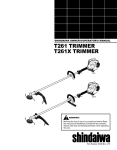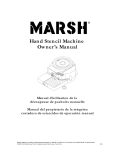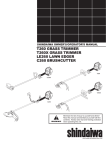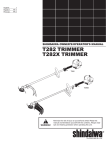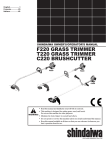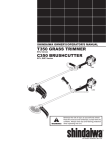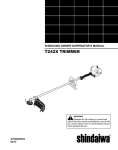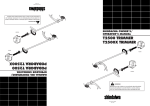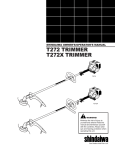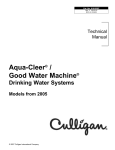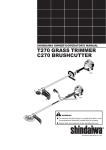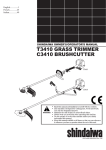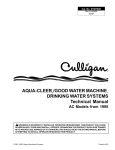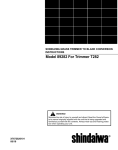Download Shindaiwa M230 EMC Operator`s manual
Transcript
ENGLISH SHINDAIWA OWNER’S/OPERATOR’S MANUAL T230 GRASS TRIMMER T230X GRASS TRIMMER C230 BRUSHCUTTER T230 T230X C230 WARNING! Minimize the risk of injury to yourself and others! Read this manual and familiarize yourself with the contents. Always wear eye and hearing protection when operating this unit. ® Part Number 62064-94013 Rev. 8/06 Introduction Attention Statements General Safety Instructions Shindaiwa 230-series hand held power equipment has been designed and built to deliver superior performance and reliability without compromise to quality, comfort, safety or durability. Throughout this manual are special “Attention Statements.” Work Safely Shindaiwa’s high-performance engines represent the leading edge of 2-cycle engine technology, delivering exceptionally high power with remarkably low displacement and weight. As an owner/operator, you’ll soon discover for yourself why Shindaiwa is simply in a class by itself! IMPORTANT! The information contained in this owner's/ operator's manual describes units avail able at the time of publication. Shindaiwa Inc. reserves the right to make changes to products without prior notice, and without obligation to make alterations to units previously manufactured. Contents PAGE Attention Statements....................................3 Safety Information.........................................4 Safety Labels..................................................4 Unit Description............................................5 Specifications.................................................5 Assembly........................................................6 Mixing Fuel.................................................11 Starting the Engine.....................................12 Stopping the Engine...................................12 Adjusting Engine Idle.................................13 WARNING! A statement preceded by the trian gular attention symbol and the word “WARNING” contains information that should be acted upon to prevent seri ous bodily injury. Using the Trimmer (T230) .......................14 Using the Brushcutter (C230)...................15 Maintenance................................................16 Long Term Storage.....................................19 Blade Sharpening........................................19 Troubleshooting Guide..............................20 Emission System Warranty........................22 WARNING! Never make unauthorized attachment installations. CAUTION! A statement preceded by the word “CAUTION” contains information that should be acted upon to prevent me chanical damage. IMPORTANT! A statement preceded by the word “IMPORTANT” is one that possesses special significance. NOTE: A statement preceded by the word “NOTE” contains information that is handy to know and may make your job easier. Read and follow this operators manual. Failure to do so could result in serious injury. Wear eye and hearing protection at all times during the operation of this unit. Keep bystanders at least 50 feet (15 m) away during operation. Beware of thrown or ricocheted objects. Checking Unit Condition...........................13 Shoulder Strap.............................................13 Trimmers and brushcutters operate at very high speeds and can do serious damage or injury if they are misused or abused. Never allow a person without training or instruction to operate this unit! Do not operate this unit with a blade unless the unit is equipped with a Shindaiwa-approved handlebar or barrier. Always wear a harness when operating this unit with a blade. A harness is also recommended when using trimmer line. If unit is used as a brushcutter, beware of blade thrust. A jammed blade can cause the unit to jerk suddenly and may cause the operator to lose control of the unit. IMPORTANT! The operational procedures described in this manual are intended to help you get the most from unit as well as to protect you and others from harm. These proce dures are guidelines for safe operation un der most conditions, and are not intended to replace any safety rules and/or laws that may be in force in your area. If you have questions regarding your Shindaiwa power tool, or if you do not understand something in this manual, your Shindaiwa dealer will be glad to assist you. You may also contact Shindaiwa, Inc. at the ad dress printed on the back of this manual. WARNING! Use Good Judgment NEVER run the engine when transport ing the unit. NEVER run the engine indoors! Make sure there is always good ventilation. Fumes from engine exhaust can cause serious injury or death. ALWAYS use the proper cutting tool for the job. ALWAYS stop the unit immediately if it suddenly begins to vibrate or shake. Inspect for broken, missing or improp erly installed parts or attachments. NEVER extend trimming line beyond the length specified for your unit. ALWAYS keep the unit as clean as practical. Keep it free of loose vegeta tion, mud, etc. ALWAYS hold the unit firmly with both hands when cutting or trimming, and maintain control at all times. ALWAYS keep the handles clean. ALWAYS disconnect the spark plug wire before performing any main tenance work. ALWAYS, if a saw blade should bind fast in a cut, shut off the engine imme diately. Push the branch or tree to ease the bind and free the blade. General Safety Instructions The Properly Equipped Operator Stay Alert You must be physically and mentally fit to operate this unit safely. WARNING! Never operate power equipment of any kind if you are tired or if you are under the influence of alcohol, drugs, medication or any other substance that could affect your ability or judgement. Wear hearing protection devices and a broad-brimmed hat or helmet. Wear close-fitting clothing to protect legs and arms. Gloves offer added protection and are strongly recommended. Do not wear clothing or jewelry that could get caught in machinery or underbrush. Secure long hair so that it is above shoulder level. NEVER wear shorts! Always wear eye protection such as goggles or safety glasses to shield against thrown objects. Always wear a harness when operating a unit equipped with a blade. Always operate with both hands firmly gripping the unit. WARNING! Minimize the Risk of Fire! NEVER smoke or light fires near the unit. When operating with a blade, make sure the handle is positioned to provide you with maximum protection from contacting the blade. ALWAYS stop the engine and allow it to cool before refueling. Avoid overfill ing and wipe off any fuel that may have spilled. ALWAYS inspect the unit for fuel leaks before each use. During each refill, check that no fuel leaks from around the fuel cap and/or fuel tank. If fuel leaks are evident, stop using the unit immediately. Fuel leaks must be re paired before using the unit. Keep a proper footing and do not overreach. Maintain your balance at all times during operation. Keep away from the rotating trimmer line or blade at all times, and never lift a moving attachment above waist-high. ALWAYS move the unit to a place well away from a fuel storage area or other readily flammable materials before starting the engine. NEVER place flammable material close to the engine muffler. NEVER run the engine without the spark arrester screen in place. Wear appropriate footwear (non-skid boots or shoes): do not wear open-toed shoes or sandals. Never work barefooted! Always make sure the appropriate cutting attachment shield is correctly installed and in good condition. Figure 1 Safety Labels IMPORTANT! Safety and Operation Information Labels: Make sure all information labels are undamaged and readable. Immediately replace damaged or missing information labels. New labels are available from your local authorized Shindaiwa dealer. READ THE OPERATOR’S MANUAL WEAR HEARING AND ANSI Z87.1 APPROVED EYE PROTECTION 50 FEET (15m) KEEP BYSTANDERS AWAY AT LEAST 50 FEET (15m) T230 BEWARE OF THROWN OR RICOCHETED OBJECTS DO NOT OPERATE THIS MACHINE WITH A BLADE Shindaiwa Inc. 19422-00028 This label indicates the minimum distance between front handle and rear grip per ANSI B175.3. T230X C230 Figure 2 Be Aware of the Working Environment (all units) Avoid long-term operation in very hot or very cold weather. Make sure bystanders or observers outside the 50-foot “danger zone” wear eye protection. 50 FEET Be extremely careful of slippery terrain, especially during rainy weather. Reduce the risk of bystanders being struck by flying debris. Make sure no one is within 50 feet (15 meters)—that’s about 16 paces—of an operating attachment. If contact is made with a hard object, stop the engine and inspect the cutting attachment for damage. Be constantly alert for objects and debris that could be thrown either from the rotating cutting attachment or bounced from a hard surface. Figure 3 Always make sure the appropriate cutting attachment shield is correctly installed. 26105 Beware of a coasting blade when brushcutting or edging. A coasting blade can injure while it continues to spin after the throttle trigger is released or after the engine is stopped. ALWAYS clear your work area of trash or hidden debris that could be thrown back at you or toward a bystander. When operating in rocky terrain or near electric wires or fences, use extreme caution to avoid contacting such items with the cutting attachment. Unit Description Using the accompanying illustrations as a guide, familiarize yourself with this unit and its various components. Understanding the product helps ensure top performance, long service life, and safer operation. See Figure 4. Ignition Switch Fuel Tank Outer Tube Throttle Trigger Gearcase WARNING! Tank T230 Protector GRASS TRIMMER Handle (for trimmer use only) Do not make unauthorized modifica tions or alterations to any of these units or their components. Trimmer Head Grip Ignition Hanger Switch Cutting Attachment Shield Handle Gearcase Barrier Cutting Attachment Shield Ignition Switch Throttle Trigger Trimmer Head Shoulder Strap Outer Tube Handlebar Gearcase Cutting Attachment Shield Brushcutter Blade Spark Plug Fuel Tank Tank Protector Throttle T230X Trigger GRASS TRIMMER Outer Tube Specifications Spark Plug Grip Spark Plug Fuel Tank Tank Protector C230 BRUSHCUTTER Figure 4 T230 Dry Weight (less attachments)..........................4.6 kg/10.2 lb. Fuel Tank Capacity..................................................... 554 ml/18.7 oz. T230X Dry Weight (less attachments).......................4.7 kg/10.4 lb. Carburetor Type................................. Walbro WYL, diaphragm-type C230 Dry Weight (less attachments)..........................4.9 kg/10.8 lb. Ignition........................... One-piece electronic, transistor-controlled Engine Model............................................................. Shindaiwa S230 Spark Plug..................................................................... Champion CJ8 (for EMC compliance use NGK BMR6A) Engine Type.............................. 2-cycle, vertical-cylinder, air-cooled Bore x Stroke............................................ 32 x 28 mm/1.26 x 1.10 in. Displacement........................................................... 22.5 cc/1.4 cu. in. Maximum Power Output....... 1.1 HP (0.8 kW) @ 7500 RPM (min-1) Fuel/Oil Ratio...................................................... 50:1 with Shindaiwa Premium 2-cycle mixing oil Air Cleaner Type................... Non-reversible flocked filter element Starting Method..........................................................................Recoil Stopping Method...............................................................Slide switch Transmission Type..............................Automatic, centrifugal clutch w/bevel gear *Specifications are subject to change without notice. Prior to Assembly Before assembling, make sure you have all the components required for a complete unit: Engine assembly. Outer tube assembly. Cutting attachment shield. Cutting attachment (trimmer head, or brushcutter blade). Correct operators handle (see page 8). Kit containing cutting attachment shield mounting bracket and hardware, operator’s handle mounting bracket and hardware, gearcase tool holder, this manual and tool kit for routine maintenance. Tool kits vary by model and may include a hex wrench, spanner and a combination spark plug wrench/screwdriver. IMPORTANT! The terms “left”, “left-hand”, and “LH”; “right”, “right-hand”, and “RH”; “front” and “rear” refer to directions as viewed by the operator during normal operation. Carefully inspect all components for damage. Assembly Driveshaft/Powerhead All Models Connect the Outer Tube to the Powerhead. 1. Place the powerhead on a clean, flat surface, spark plug facing up. See Figure 6. 2. Use the 4 mm hex wrench to loosen the tube clamp screw. Tube Clamp Decal Hex Wrench Clamp Figure 6A Ignition Switch 3. Add some moly-type Figure 5 EP grease to the splines on the end of the mainshaft. 5. Position the outer tube so that the ignition switch is facing up and the throttle trigger is down. Spark Plug Main Shaft C230 Brushcutter 4. Slide the outer tube into the tube clamp until the tube bottoms. If installation is difficult, rotate the outer tube or mainshaft slightly until you feel the mainshaft splines engage with the powerhead. T230 Clamp must fit next to line on outer-tube decal Grip Clamp Screw Tube Clamp Outer Tube Throttle Trigger Figure 6 T230 S lide the outer tube into the powerhead until the throttle grip just contacts the tube clamp. C230 S lide the outer tube into the powerhead until the installation decal aligns with the tube clamp. See Figure 6A. 6. Tighten the clamp screw firmly. CAUTION! Do not force the shaft tube into the powerhead! Excessive force can dam age the shaft tube and mainshaft. Assembly Handle T230 - Connect the Handle to the Outer Tube. Socket-head Caps Screws Handle 1. Position the handle on the outer tube forward of Handle Positioning Label as shown in Figure 7. 2. Install the mounting bracket with the socket head cap screws. Tighten the screws finger-tight ONLY at this time. Outer Tube 3. Locate the handle in the best position for operator comfort (usually about 10 inches ahead of the throttle housing). 4. Secure the handle by alternately tightening the four socket-head screws in a diagonal or “crisscross” fashion. Handle Positioning Label Mounting Bracket Figure 7 T230X - Connect the Handle to the Outer Tube. Socket-head Caps Screws 1. Position the handle on the outer tube forward of Handle Positioning Label as shown in Figure 8. 2. Install the barrier bar with the socket head cap screws and nuts. Tighten the screws finger-tight only at this time. Handle Throttle Assembly Outer Tube 3. Locate the handle in the best position for operator comfort (usually about 10 inches ahead of the throttle housing). 4. Secure the handle by alternately tightening the four socket-head screws in a diagonal or “crisscross” fashion. Throttle Assembly Handle Positioning Label Barrier Figure 8 Assembly Handlebar C230 Handle Positioning Label Ignition Switch Assemble the Handlebar. 1. Position the handle over the outer tube. See Figure 9. Make sure the throttle lever is on the right-hand side of the outer tube. Shoulder Strap 2. Attach the handle mounting bracket using the two socket-head cap screws. Tighten the screws finger-tight ONLY at this time. Hanger Throttle Trigger 3. Locate the handle forward of the Handle Positioning Label at the best position for operator comfort. 4. Using the hex wrench, securely tighten the two handlebar cap screws. Throttle Cable Protector Sleeve 5. Route the ribbed throttle cable tube along the handlebar and outer tube. See Figure 9. Install the protector sleeve on the outer tube. Handlebar Mounting Bracket Socket-Head Cap Screw Outer Tube Figure 9 Assembly Throttle Linkage and Ignition Leads All Models Loosen the cylinder cover knob and disconnect the spark plug cap Install the black wire between the two cable adjuster nuts. Ignition Ground Lead Remove the Cylinder Cover. Cable Adjuster Nut 1. Remove the cap from the spark plug. 2. Loosen the black cylinder cover knob (about a dozen full turns are required), and then lift off the cylinder cover. NOTE: If the cover binds on the muffler outlet tube, pull gently on the corner of the cover as shown (see inset). Connect the Throttle Cable. Figure 11 Connect the throttle cable Lift the corner of the cover 23013 1. Route the ribbed cable over the tube clamp to the top left side of the engine. 2. Install the black wire between the two cable adjuster nuts as shown. See Figure 11. 3. Connect the S-shaped end of the throttle cable to the throttle lever on top of the carburetor. See Figure 12. 23014 Figure 10 Figure 12 Assembly Throttle Linkage and Ignition Leads All Models Assemble and Adjust the Throttle Cable. 1. Insert the throttle-cable housing into the notch on the fan cover, and clamp the ground wire terminal between the fan cover and the outer cable adjuster nut. See Figure 13. Red Wire Black Ignition Wire Cable Adjuster Nuts 2. Tighten the two throttle cable adjuster nuts. IMPORTANT! Adjust and tighten the cable nuts to allow approximately 1/4-inch free play at the throttle trigger. 3. Using finger pressure only, connect the black ignition wire from the cable tube to the red ignition wire on the powerhead. Wire routing must be as shown in the illustration with the black wire located away from the throttle cable and carburetor linkage. 4. Reinstall the engine cover and tighten the captive engine cover screw. 5. Reinstall the spark plug boot. CAUTION! Routing of wiring must not interfere with throttle operation. Ground Wire Ground Wire Terminal Figure 13 Reinstall the Spark Plug Cap Assembly Cutting Attachment Shield All Models Socket-Head Cap Screw T230 Outer Tube Upper Clamp Cutting Attachment Shield Bracket Shim Shim Nuts Clamp Screw Line Cutter Shim Shim Retaining Nut T230X/C230 Bolt Cutting Attachment Shield Mounting Plate Figure 14 Install the Cutting Attachment Shield T230/T230X/C230. 1. Insert the cutting attachment shield between the outer tube and the cutting attachment shield mounting plate. See Figure 14. NOTE: It may be necessary to loosen the retaining nut and clamp screw to adjust cutting attachment shield mounting plate. 2. Fit the two shims and the bracket over the outer tube and loosely install the four socket-head cap screws. See Figure 14. 3. Tighten the four socket-head cap screws to secure the cutting attachment shield. Nut Figure 14A Hex 26013 Screws Cutting Attachment Shield Cutting Attachment Shield WARNING! NEVER operate the unit without the cutting attachment shield installed and tightly secured! Hook Receiver Sub-Shield T230X and C230. (when trimmer head is in use) 1. Attach the shield extension to the cutting attachment shield. Sub-shield Figure 15 WARNING! NEVER use this machine without subshield when using a trimmer head. CAUTION! Hook CAUTION! Make sure the sub-guard is completely hooked at the hook receiver. Make sure the clamp screw and retaining nut are securely tightened before tighten ing the four socket-head cap screws. To Change Position of Line Cutter. The line cutter can be positioned in 2 positions to obtain different line length for cutting. 1. Remove the 2 hex screws with a 4 mm hex wrench. See Figure 14A. 2. Rotate line cutter. See Figure 14A. 3. Reinstall the two hex screws and tighten them securely. NOTE: Be careful to not lose the 2 nuts in the cutting attachment shield, they are not captured. WARNING! The line cutter is very sharp. Wear gloves to protect your hands when handling. Assembly Trimmer Head C230/T230/T230X Model Holder Remove the T230 retaining plug Output Shaft Shaft Bolt Bolt Guard Model C230/T230X Output Shaft Holder B 5. Using hand pressure only, tighten the trimmer head firmly on the gearshaft. Holder A 6. Remove the hex wrench. 7. Adjust the trimmer line length to reach no further than the line cutter on the cutting attachment shield. Trim to the correct length if necessary. 23019 Thread on the trimmer head Install the trimmer head Install the Trimmer Head. 1. Turn the unit over so that the gearcase output shaft faces UP. 2. (T230) Remove and discard the plastic retaining plug. See Figure 16. (T230X/C230) Remove the shaft bolt and bolt guard using the combination spark plug wrench/screwdriver. See Figure 17. Holder B Holder A Figure 17 Figure 16 4. While holding the hex wrench, thread the trimmer head onto the output shaft, turning counter-clockwise. 3. Rotate the holder until the hole in the holder aligns with the notch on the gearcase flange. Use the long end of the hex wrench to lock the output shaft in position. See Figure 16 or 17. IMPORTANT! The trimmer head has a left-hand thread. Turn the trimmer head counter-clockwise to install and clockwise to remove. WARNING! A standard grass trimmer unit with loop handle should NEVER be operated with blade-type attachments. For blade use, the trimmer must be fitted with a bicycletype handlebar or barrier bar that is lo cated in front of the operator to reduce the risk of the operator coming in contact with the cutting attachment. (Per ANSI B175.3). When using a blade, the unit must be equipped with a harness or strap. The 230 unit should now be completely assembled and ready for use as a grass trimmer. Assembly Blade C230/T230X NOTE: When installing certain blades, it may be necessary to temporarily remove the safety clip. Slide the safety clip off-center Shaft Bolt Bolt Guard Safety Clip Holder “B” Output Shaft Gear Shaft Safety Clip CAUTION! Install the blade so its printed surface is visible to the operator when the brushcutter is in the normal operating position. Holder “A” WARNING! Figure 19 The blade must fit flat against the holder flange. The blade mounting hole must be centered over the raised boss on blade holder A. Hex Wrench Figure 18 Mount the Blade. Turn the brushcutter upside down so the gearcase output shaft is facing UP, and remove the shaft bolt, bolt guard and holder B from the gearcase shaft. 1. Align the hole in blade holder “A” with the matching hole in the gearcase flange, and then temporarily lock the 10 Slide the saw blade in place Figure 20 Center the safety clip output shaft by inserting a hex wrench through both holes. See Figure 18. 2. Slide the safety clip off-center. See Figure 18. 3. Fit the blade over the safety clip and then center it over the flange on holder “A”. See Figure 19. 4. Lock the blade in place by centering the safety clip on the output shaft. See Figure 18. WARNING! Never operate the brushcutter without the safety clip in place! Assembly Blade C230/T230X (continued) 5. Install blade holder “B” on the output shaft. See Figure 21. The recess in the holder must completely cover the safety clip, and must fit tightly against the blade. Blade Output Shaft Bolt Guard Blade Holder B 6. Install the bolt guard and then the blade retaining bolt. Using the combination spark plug wrench/screwdriver, tighten the bolt firmly in a counter-clockwise direction. 7. Remove the hex wrench. Hex Wrench (blade not shown for clarity) The C230 Brushcutter should now be completely assembled. Tighten the assembly (blade not shown for clarity) Figure 21 Mixing Fuel CAUTION! CAUTION! Examples of 50:1 mixing quantities n Some types of gasoline contain al cohol as an oxygenate. Oxygenated gasoline may cause increased op erating temperatures. Under certain conditions, alcohol-based gasoline may also reduce the lubricating qualities of some 2-cycle mixing oils. This engine is designed to operate on a 50:1 mixture consisting of unleaded gasoline and 2-cycle mixing oil only. Use of non-approved mixing oils can lead to excessive carbon deposits. n 1 gallon of gasoline to 2.6 oz. mixing oil. n Never use any type of gasoline containing more than 10% alcohol by volume! Generic oils and some outboard oils may not be intended for use in high-performance 2-cycle type engines, and should never be used in your Shindaiwa engine. n Use only fresh, clean unleaded gasoline with a pump octane of 87 or higher. n Mix with 50:1 Shindaiwa Premium 2-cycle mixing oil or with an equivalent high quality 2-cycle mixing oil. n 5 liters of gasoline to 100 ml. mixing oil. IMPORTANT! Mix only enough fuel for your immediate needs! If fuel must be stored longer than 30 days and oil with fuel stabilizer is not used, it should first be treated with a fuel stabilizer such as STA-BIL™. Filling the Fuel Tank 1. Place the unit on a flat, level surface. WARNING! Minimize the Risk of Fire! n STOP engine before refueling. n ALWAYS allow the engine to cool before refueling! n Wipe all spilled fuel and move the engine at least 10 feet (3 meters) from the fueling point and source before restarting! n NEVER start or operate this unit if there is a fuel leak. n NEVER start or operate this unit if the carburetor, fuel lines, fuel tank and/or fuel tank cap are damaged. n NEVER smoke or light any fires near the engine or fuel source! 2. Clear any dirt or other debris from around the fuel filler cap. 3. Remove the fuel cap, and fill the tank with clean, fresh fuel. 4. Reinstall the fuel filler cap and tighten firmly. n NEVER place any flammable mate rial near the engine muffler! n NEVER operate the engine without the muffler and spark arrester in good working condition. 11 Starting the Engine IMPORTANT! Engine ignition is controlled by a two position switch mounted on the throttle housing labeled, “I” for ON or START and “O” for OFF or STOP. Make sure the cutting attachment is clear of obstructions! IMPORTANT! If the engine fails to start after several at tempts with the choke in the closed posi tion, the engine may be flooded with fuel. If flooding is suspected, move the choke lever to the open position and repeatedly pull the recoil starter to remove excess fuel and start the engine. If the engine still fails to start, refer to the troubleshooting section of this manual. When the Engine Starts... Figure 25 23032 Figure 22 1. Slide the ignition switch to the “I” position (engine ON). 4. While holding the outer tube firmly with one hand, slowly pull the recoil starter handle until resistance is felt, then pull quickly to start the engine. CAUTION! Return Tube Do not pull the recoil starter to the end of the rope travel. Pulling the recoil starter to the end of the rope travel can damage the starter. WARNING! Primer Bulb The cutting attachment may rotate when the engine is started! Figure 23 2. Press the primer bulb until fuel can be seen flowing in the transparent return tube. IMPORTANT! The primer system only pushes fuel through the carburetor. Repeatedly pressing the primer bulb will not flood the engine with fuel. 3. (Cold Engine Only) Set the choke lever to the CLOSED position. 12 Advancing the throttle makes the cutting attachment turn faster; releasing the throttle permits the attachment to stop turning. If the cutting attachment continues to rotate when the engine returns to idle, carburetor idle speed should be adjusted (page 13). Stopping the Engine 23037 Figure 27 Open Figure 26 23034 After the engine is warm, pick up the unit and clip on the harness if so equipped. See page 13. 5. When the engine starts, slowly move the choke lever to the “OPEN” position. See Figure 26. (If the engine stops after the initial start, close the choke and restart.) Idle the engine briefly before stopping (about 2 minutes), then slide the ignition switch to the “O” (Engine OFF) position. Closed Figure 24 After the engine starts, allow the engine to warm up at idle 2 or 3 minutes before operating the unit. 23036 WARNING! Never start the engine from the operat ing position. Adjusting Engine Idle Idle Adjusting Screw The engine must return to idle speed whenever the throttle lever is released. Idle speed is adjustable, and must be set low enough to permit the engine clutch to disengage the cutting attachment. Idle Speed Adjustment WARNING! Figure 28 The cutting attachment must NEVER rotate at engine idle! If the idle speed cannot be adjusted by the procedure described here, return the unit to your Shindaiwa dealer for inspection. 1. Place the unit on the ground, then start the engine, and then allow it to idle 2-3 minutes until warm. 2. If the attachment rotates when the engine is at idle, reduce the idle speed by turning the idle adjustment screw counter-clockwise. See Figure 26. 3. If a tachometer is available, the engine idle speed should be final adjusted to 2,750 (±250) RPM (min-1). 4. Carburetor fuel mixture adjustments are preset at factory on units with emission control systems and cannot be serviced in the field. Checking Unit Condition NEVER operate the unit with the cutting attachment shield or other protective devices (harness, ignition switch, blade retention clip, etc.) removed! WARNING! A cutting attachment shield or other protective device is no guarantee of protection against ricochet. YOU MUST ALWAYS GUARD AGAINST FLYING DEBRIS! Use only authorized Shindaiwa parts and accessories with your Shindaiwa trimmer, brushcutter, or lawn edger. Do not make modifications to this unit without the written approval of Shindaiwa, Inc. ALWAYS make sure the cutting attachment is properly installed and firmly tightened before operation. NEVER allow the engine to run at high RPM without a load. Doing so could damage the engine. NEVER use a cracked or warped cutting attachment: If a properly installed attachment vibrates, replace the attachment with new one and re-check. NEVER operate a unit with worn or damaged fasteners or attachment holders. ALWAYS stop the engine immediately and check for damage if you strike a foreign object or if the unit becomes tangled. Do not operate with broken or damaged equipment. Shoulder Strap NEVER cut with a dull blade. Doing so will increase the risk of blade thrust and may also cause equipment damage. NOTE: Using a shoulder strap with a brush-cutter allows you to maintain proper control of the unit and reduces fatigue during extended operation. Adjust the shoulder strap so the shoulder pad rests comfortably on the off-side shoulder and the cutting path of the cutting attachment is parallel to the ground. Make sure all hooks and adjustment devices are secure. Optional Accessories Shoulder Strap....................P/N 22410-17202 Hanger.................................P/N 22410-12210 Shoulder strap required for use with brushcutters Hanger Bolt........................P/N 01020-05120 Hanger Nut.........................P/N 01500-05041 Grass Trimming NOTE: Although a shoulder strap accessory is not required for use with a grass trimmer, a shoulder strap can increase operator comfort during extended periods of operation. See Figure 29. Figure 29 Using a Blade WARNING! Always wear a shoulder strap when op erating this unit with a blade. A shoul der strap is also recommended when using trimmer line. Figure 30 13 Using a Grass Trimmer T230 Your Shindaiwa T230 Grass Trimmer may be equipped with one of several Shindaiwa trimmer head models, each with features for specific applications and/or operational requirements. NOTE: A grass trimmer head can also be fitted to the Shindaiwa C230 Brushcutter. For proper operation, always refer to the instructions accompanying the trimmer head being used. Available trimmer head styles include: Semi-automatic. Trimmer line is indexed when the operator taps the trimmer head on the ground during operation. Manual. The operator indexes line manually with the grass trimmer stopped. Fixed. The operator must stop the unit and add new lengths of trimmer line manually. Flail. This device, designed for clearing weeds and light brush, features three nylon blades attached to the head by pivots. CAUTION! Do not push the rotating line into trees, wire fences or any material that could tangle or break line ends. Engine Operating Speeds Operate at full throttle while cutting grass. CAUTION! Operation at low RPM can lead to pre mature clutch failure. Trimming and Mowing Grass Hold the grass trimmer so the trimmer head is angled slightly into the area to be cut. To ensure maximum trimmer-line service life, cut only with the tip of the trimmer line. Cut grass by swinging the unit's trimmer head from left to right. Keep the trimmer head horizontal. 23041 Figure 31 Edging Tilt the handle about 100° to the left (from horizontal) and move forward, holding the trimmer vertically as shown. 23042 Figure 32 14 Using A Brushcutter Blade C230/T230X Blade Thrust WARNING! Before working with a bladeequipped unit, always inspect and clean the area of objects that could interfere with or damage the blade. Never use a blade near sidewalks, fence posts, buildings or other objects that could cause injury or damage. Never use a blade for purposes other than those for which it was designed. Whenever you strike a hard ob ject with a blade, always stop the brushcutter and carefully inspect the blade for damage. NEVER OPERATE THE BRUSHCUTTER WITH A DAMAGED BLADE! A blade-equipped unit must be equipped with a bicycle-type handle bar as well as a harness or strap. Always make sure the cutting at tachment shield is properly installed before operating the unit. ‘Blade thrust’ is a sudden sideways or backward motion of the brushcutter. Such motion may occur when the blade jams or catches on an object such as a sapling tree or tree stump. BE CONSTANTLY ALERT FOR BLADE THRUST AND GUARD AGAINST ITS EFFECTS! WARNING! When cutting wood with a blade, feed the blade slowly. Never strike or “slam” a spinning blade against the wood. Brushcutter Handlebar A brushcutter’s handlebar helps prevent the operator from moving forward, or the unit moving rearward, thus preventing inadvertent bodily contact with the blade. ALWAYS KEEP THE HANDLEBAR SECURELY IN PLACE ON THE UNIT! Brushcutter Harness When operating a brushcutter, make sure both the handle and harness are adjusted to the size of the operator using the unit. Engine Operating Speeds Operate the engine at full throttle while cutting. Best fuel efficiency is obtained by releasing the throttle when swinging back after a cut. To prevent possible engine damage, do not allow the brushcutter to run at high speeds without a load. Avoid operating the attachment at low speeds. Doing so can lead to rapid clutch wear. In addition, slow-speed operation tends to cause grass and debris to wrap around the cutting head. WARNING! DO NOT use 2-tooth or NONShindaiwa approved 4-tooth cutting blades with Shindaiwa brushcutters. A harness provides additional protection against blade thrust. In addition, a harness gives significant support and comfort to help ensure safe and efficient operation. Vertical Cuts The blade rotates counter-clockwise. For best performance and to minimize being struck by debris, move the blade from right to left while advancing on your work. (T230X, C230) Position the blade so cuts are made between the blade’s 8 o’clock and 10 o’clock positions (as viewed from above). DO NOT cut between the 10 o’clock and 5 o’clock positions (shaded area). See Figure 33. Cut on the left side of the blade. KEEP YOUR BODY OUTSIDE THE PATH OF BLADE ROTATION WARNING! When making vertical cuts, never allow the blade to exceed waist height. T230X/C230 Ten O'clock DO N T O CU T Blade Rotation OK To Cut Hold the brushcutter with the blade at a 90° angle to the ground so the blade’s bottom edge rotates toward the operator. Move the blade from top to bottom through the cut, and cut only with the bottom edge of the blade. Eight O'clock Figure 33 Figure 34 Five O'clock 15 General Maintenance IMPORTANT! MAINTENANCE, REPLACEMENT OR REPAIR OF EMISSION CONTROL DEVICES AND SYSTEMS MAY BE PERFORMED BY ANY REPAIR ESTABLISHMENT OR INDIVIDUAL; HOWEVER, WARRANTY REPAIRS MUST BE PERFORMED BY A DEALER OR SERVICE CENTER AUTHORIZED BY SHINDAIWA CORPORATION THE USE OF PARTS THAT ARE NOT EQUIVALENT IN PERFORMANCE AND DURABILITY TO AUTHORIZED PARTS MAY IMPAIR THE EFFECTIVENESS OF THE EMISSION CONTROL SYSTEM AND MAY HAVE A BEARING ON THE OUTCOME OF A WARRANTY CLAIM. WARNING! Before performing any maintenance, repair or cleaning work on the unit, make sure the engine and cutting attachment are completely stopped. Disconnect the spark plug wire before performing service or maintenance work. Blades WARNING! Non-standard parts may not operate properly with your unit and may cause damage and lead to personal injury. NOTE: Using non-standard replacement parts could invalidate your Shindaiwa warranty. Muffler This unit must never be operated with a faulty or missing spark arrester or muffler. Make sure the muffler is well secured and in good condition. A worn or damaged muffler is a fire hazard and may also cause hearing loss. Spark Plug Keep the spark plug and wire connections tight and clean. Fasteners Make sure nuts, bolts, and screws (except carburetor adjusting screws) are tight. Keep blades sharp and check blade condition frequently. If a blade’s performance changes suddenly, stop the engine and check the blade for cracks or other damage. Replace a damaged blade IMMEDIATELY! WARNING! Never repair a damaged blade by welding, straightening, or by modify ing its shape. An altered blade may break during operation, resulting in serious personal injury. DO NOT use 2-tooth or NONShindaiwa approved 4-tooth cutting blades on Shindaiwa trimmers or brushcutters. Blades are not interchangeable between Shindaiwa edgers and trim mer/brushcutter models. Operating any unit with a blade or attachment not approved for that unit can be hazardous and may cause serious injury. Daily Maintenance Prior to each work day, perform the following: Remove all dirt and debris from the Carefully remove any accumulations engine, check the cooling fins and air of dirt or debris from the muffler and cleaner for clogging, and clean as necesfuel tank. Dirt build-up in these areas sary. can lead to engine overheating, fire, or premature wear. Check for loose or missing screws or components. Make sure the cutting attachment is securely fastened. Check the entire unit for leaking fuel or grease. 10-Hour Maintenance Ever y 10 hours of operation (more frequently in dusty or dirty conditions): Remove the air cleaner element from the carburetor and clean it thoroughly with soap and water or compressed air, let dry before reinstalling the element. Loosen Knob CAUTION! Do not operate the machine if the air cleaner or element is damaged, or if the element is wet. Figure 35 16 23047 Remove and clean or replace the element 10/15-Hour Maintenance Ever y 10 to 15 hours of operation: Remove and clean the spark plug. Clean the spark plug and check the gap at the electrode. Adjust the spark plug electrode gap to 0.024-inch (0.6 mm). If the plug must be replaced, use only a Champion CJ8 or equivalent spark plug of the correct heat range. For electromagnetic compliance (EMC), use NGK BMR6A. 0.024-inch (0.6 mm) CAUTION! 23048 Before removing the spark plug, clean the area around the plug to prevent dirt and debris from getting into the engine’s internal parts Figure 36 50-Hour Maintenance Ever y 50 hours of operation (more frequently in dusty or dirty conditions): Remove and clean the cylinder cover and clean grass and dirt from the cylinder fins. Remove the cutting attachment, holder and the gear shaft collar. Remove the filler plug from the side of the gearcase and press new grease into the gearcase until the old grease has been pushed out. Use only lithium-base grease such as Shindaiwa Gearcase Lubricant or equivalent. See Figure 37. Use a hooked wire to extract the fuel filter from inside the fuel tank. Remove and replace the filter element. Before reinstalling the filter, inspect the condition of the fuel line. If damage or deterioration are noted, the unit should be removed from service until it can be inspected by a Shindaiwa-trained service technician. See Figure 38. ALL UNITS Hooked Wire CAUTION! Make sure you do not pierce the fuel line with the end of the hooked wire, the line is delicate and can be dam aged easily. 23051 Filter Element Figure 38 New Grease Old Grease Gear Shaft Collar Figure 37 17 135-Hour Maintenance After ever y 135 hours of operation or if engine becomes hard to start and has low power. The spark arrester screen should be inspected and cleaned. Engine Cover Engine Cover Knob WARNING! Never operate the unit with a damaged or missing muffler or spark arrester! Operating with missing or damaged ex haust components is a fire hazard and could also damage your hearing. 1. Remove the spark plug boot. 2. Remove the engine cover by loosening the engine cover knob (the knob is captive) and lifting the cover from the engine. Muffler 3. Remove the spark arrester screen screw. Spark Arrestor Retaining Screw 4. Remove the spark arrester screen and clean with a stiff bristle brush. IMPORTANT! If carbon deposits are severe or if no performance improvement is noted, this unit should be inspected by an authorized Shindaiwa servicing dealer. 5. Reassemble the spark arrester screen and engine cover in reverse order. 18 Spark Arrester Screen Figure 39 23055 Long Term Storage Whenever the unit will not be used for 30 days or longer, use the following procedures to prepare it for storage: Clean external parts thoroughly. Drain all the fuel from the carburetor and the fuel tank. IMPORTANT! All stored fuels should be stabilized with a fuel stabilizer such as STA-BIL™. To remove the remaining fuel from the fuel lines and carburetor and with the fuel drained from the fuel tank. 1. Prime the primer bulb until no more fuel is passing through. Remove the spark plug and pour about 1/4 ounce of 2-cycle mixing oil into the cylinder through the spark plug 2. Start and run the engine until it stops hole. Slowly pull the recoil starter 2 or 3 running. times so oil will evenly coat the interior 3. Repeat steps 1 and 2 until the engine will of the engine. Reinstall the spark plug. no longer start. Before storing the unit, repair or replace any worn or damaged parts. CAUTION! Gasoline stored in the carburetor for extended periods can cause hard start ing, and could also lead to increased service and maintenance costs. Remove the air cleaner element from the carburetor and clean it thoroughly with soap and water, let dry and reassemble the element. Store the machine in a clean, dust-free area. Blade Sharpening When the cutting edges of the blade become dull, they can be resharpened with a few strokes of a file. In order to keep the blade in balance, all cutting edges must be sharpened equally. Multiple-tooth Circular Blade Round File Use a round file to maintain a radius of 0.04 to 0.06” (1 to 1.5 mm) at the base of each tooth. Cutting edges must be offset equally on each side. Shindaiwa Tornado™ Blade To sharpen the cutters on a Shindaiwa Tornado Blade, use a 7/32-inch round file. File the leading edge of each tooth to a razor edge. The top plate of each tooth should angle back 30°. Figure 41 Round File WARNING! Sharpen only the cutting teeth of a blade. DO NOT alter the contour of the blade in any way. Figure 40 30° 19 Troubleshooting Guide ENGINE DOES NOT START What To Check Does the engine crank? Possible Cause NO Good compression? Faulty recoil starter. Fluid in the crankcase. YES Remedy Consult with an authorized servicing dealer. Internal damage. NO Loose spark plug. Tighten and re-test. Excess wear on cylinder, piston, rings. Consult with an authorized servicing dealer. NO Fuel incorrect, stale, or contaminated; mixture incorrect. Refill with fresh, clean unleaded gasoline with a pump octane of 87 or higher, mixed with Shindaiwa Premium 2-cycle mixing oil at a 50:1 gasoline/oil ratio. NO Check for clogged fuel filter and/or vent. Replace fuel filter or vent as required. Restart. NO The ignition switch is in “O” (OFF) position. Move switch to “I” (ON) position and re-start. YES Does the tank contain fresh fuel of the proper grade? YES Is fuel visible and moving in the return line when priming? YES Is there spark at the spark plug wire terminal? YES Check the spark plug. Shorted ignition ground. Faulty ignition unit. Consult with an authorized servicing dealer. If the plug is wet, excess fuel may be in the cylinder. Crank the engine with the plug removed, reinstall the plug, and restart. The plug is fouled or improperly gapped. Clean and regap the plug to 0.024” (0.6 mm). Restart. The plug is damaged internally or of the wrong size. Replace the plug with a Champion CJ8 or equivalent type spark plug of the correct heat range. For EMC compliance, use NGK BMR6A. Restart. LOW POWER OUTPUT What To Check Is the engine overheating? Possible Cause Operator is overworking the unit. Shorten trimmer line. Cut at a slower rate. Carburetor mixture is too lean. Consult with an authorized servicing dealer. Improper fuel ratio. Refill with fresh, clean unleaded gasoline with a pump octane of 87 or higher, mixed with Shindaiwa Premium 2-cycle mixing oil at a 50:1 gasoline/oil ratio Fan, fan cover, cylinder fins dirty or damaged. Carbon deposits on the piston or in the muffler. Engine is rough at all speeds. May also have black smoke and/ or unburned fuel at the exhaust. Clean or replace the air filter. Loose or damaged spark plug. Tighten or replace the plug with a Champion CJ8 or equivalent type spark plug of the correct heat range. For EMC compliance, use NGK BMR6A. Restart. Air leakage or clogged fuel line. Repair or replace fuel filter and/or fuel line. Water in the fuel. Refill with fresh fuel/oil mixture. See page 11. Faulty carburetor and/or diaphragm. 20 Consult with an authorized servicing dealer. Clogged air filter. Piston seizure. Engine is knocking. Remedy Consult with an authorized servicing dealer. Overheating condition. See above. Improper fuel. Check fuel octane rating; check for presence of alcohol in the fuel (page 11). Refuel as necessary. Carbon deposits in the combustion chamber. Consult with an authorized servicing dealer. Troubleshooting Guide (continued) ADDITIONAL PROBLEMS Symptom Poor acceleration. Engine stops abruptly. Engine difficult to shut off. Cutting attachment rotates at engine idle. Excessive vibration. Cutting attachment will not rotate. Possible Cause Remedy Clogged air filter. Clean or replace the air filter. Clogged fuel filter. Replace the fuel filter. Lean fuel/air mixture. Consult with an authorized servicing dealer. Idle speed set too low. Adjust: 2,750 (±250) RPM (min-1). Switch turned off. Reset the switch and restart. Fuel tank empty. Refuel. See page 11. Clogged fuel strainer. Replace strainer. Water in the fuel. Drain; replace with clean fuel. See page 11. Shorted spark plug or loose terminal. Clean or replace spark plug with a Champion CJ8 or equivalent type spark plug of the correct heat range. For EMC compliance, use NGK BMR6A. Tighten the terminal. Ignition failure. Replace the ignition unit. Piston seizure. Consult with an authorized servicing dealer. Ground (stop) wire is disconnected, or switch is defective. Test and replace as required. Overheating due to incorrect spark plug. Replace spark plug with a Champion CJ8 or equivalent type spark plug of the correct heat range. For EMC compliance, use NGK BMR6A. Overheated engine. Idle engine until cool. Engine idle too high. Set idle: 2,750 (±250) RPM (min-1). Broken clutch spring or worn clutch spring boss. Replace spring/shoes as required, check idle speed. Loose attachment holder. Inspect and re-tighten holders securely. Warped or damaged cutting attachment. Inspect and replace attachment as required. Loose gearcase. Tighten gearcase securely. Bent main shaft/worn or damaged bushings. Inspect and replace as necessary. Shaft not installed in powerhead or gearcase. Inspect and reinstall as required. Broken shaft. Damaged gearcase. Consult with an authorized servicing dealer. 21 The following statement only applies to United States and its territories Shindaiwa Corporation Federal Emission Design And Defect Limited Warranty Utility And Lawn And Garden Engines Shindaiwa Corporation warrants to the initial purchaser and each subsequent owner, that this utility equipment engine (herein engine) is designed, built and equipped to conform at the time of initial sale, to all applicable regulations of the U.S. Environmental Protection Agency (EPA), and that the engine is free of defects in materials and workmanship that would cause this engine to fail to conform with EPA regulations during its warranty period. This emission warranty is applicable in all States, except the State of California. For parts listed under PARTS COVERED, the dealer authorized by Shindaiwa Corporation will, at no cost to you, make the necessary diagnosis, repair, or replacement of any defective emission-related component to ensure that the engine complies with applicable U.S. EPA regulations. MANUFACTURERS WARRANTY COVERAGE When sold within the U.S., this engine’s emission control system is warranted for a period of two (2) years from the date this product is first delivered to the original retail purchaser. OWNER’S WARRANTY RESPONSIBILITIES As the engine owner, you are responsible for the performance of the required maintenance listed in your owner’s manual. Shindaiwa Corporation recommends that you retain all receipts covering maintenance on your engine, but Shindaiwa Corporation cannot deny a warranty claim solely for the lack of receipts or for your failure to ensure the performance of all scheduled maintenance. As the engine owner, you should however be aware that Shindaiwa Corporation may deny your warranty coverage if your engine or a part has failed due to abuse, neglect, improper maintenance or unapproved modifications. You are responsible for presenting your engine to the nearest dealer authorized by Shindaiwa Corporation when a problem exists. If your Shindaiwa Dealer is unable to answer questions regarding your warranty rights and responsibilities, you should then contact your Shindaiwa Distributor. For the name and telephone number of the Shindaiwa Distributor in your area, please call Shindaiwa Inc. at (503) 692-3070 between the hours of 8:00 AM and 5:00 PM Pacific Standard Time. PARTS COVERED Listed below are the parts covered by the Federal Emission Design and Defect Warranty. Some parts listed below may require scheduled maintenance and are warranted up to the first scheduled replacement of that part. The warranted parts include: 1. Carburetor Internal Components • Valve Assembly-throttle, Jet, Metering Diaphragm 2. Ignition System Components (b)the replacement parts used for required maintenance services, (c) consequential parts used for required maintenance services, (d)diagnosis and inspection fees that do not result in eligible warranty service being performed, and (e)any non-authorized replacement part, or malfunction of authorized parts due to use of non-authorized parts. MAINTENANCE AND REPAIR REQUIREMENTS You are responsible for the proper use and maintenance of the engine. You should keep all receipts and maintenance records covering the performance of regular maintenance in the event questions arise. These receipts and maintenance records should be transferred to each subsequent owner of the engine. Shindaiwa Corporation reserves the right to deny warranty coverage if the owner has not properly maintained the engine. Shindaiwa Corporation will not deny warranty repairs, however, solely because of the lack of repair, maintenance or failure to keep maintenance records. MAINTENANCE, REPLACEMENT OR REPAIR OF EMISSION CONTROL DEVICES AND SYSTEMS MAY BE PERFORMED BY ANY REPAIR ESTABLISHMENT OR INDIVIDUAL; HOWEVER, WARRANTY REPAIRS MUST BE PERFORMED BY A DEALER OR SERVICE CENTER AUTHORIZED BY SHINDAIWA CORPORATION THE USE OF PARTS THAT ARE NOT EQUIVALENT IN PERFORMANCE AND DURABILITY TO AUTHORIZED PARTS MAY IMPAIR THE EFFECTIVENESS OF THE EMISSION CONTROL SYSTEM AND MAY HAVE A BEARING ON THE OUTCOME OF A WARRANTY CLAIM. If other than the parts authorized by Shindaiwa Corporation are used for maintenance replacements or for the repair of components affecting emission control, you should assure yourself that such parts are warranted by their manufacturer to be equivalent to the parts authorized by Shindaiwa Corporation in their performance and durability. OBTAINING WARRANTY SERVICE All repairs qualifying under this limited warranty must be performed by a dealer authorized by Shindaiwa Corporation If any emission-related part is found defective during the warranty period, it is your responsibility to present the product to an authorized Shindaiwa dealer. Bring your sales receipts showing the date of purchase for this engine. The dealer authorized by Shindaiwa Corporation will perform the necessary repairs or adjustments within a reasonable amount of time and furnish you with a copy of the repair order. All parts and accessories replaced under this warranty become the property of Shindaiwa Corporation. To locate an authorized Shindaiwa dealer near you, contact your Shindaiwa Distributor. For the name and telephone number of the Shindaiwa Distributor in your area, please call Shindaiwa Inc. at (503) 692-3070 between the hours of 8:00 AM and 5:00 PM Pacific Standard Time. • Ignition Coil THIS WARRANTY IS ADMINISTERED BY • Flywheel Rotor Shindaiwa Inc. The emission control system for your particular Shindaiwa engine may also include certain related hoses and connectors. LIMITATIONS The Federal Emission Design and Defect Warranty shall not cover any of the following: 22 (a)conditions resulting from tampering, misuse, improper adjustment (unless they were made by the dealer or service center authorized by Shindaiwa Corporation during a warranty repair), alteration, accident, failure to use the recommended fuel and oil, or not performing required maintenance services, 11975 S.W. Herman Rd. Tualatin OR. 97062 (503) 692-3070 NOTES 23 ® Shindaiwa Inc. 11975 S.W. Herman Rd. Tualatin, Oregon 97062 USA Telephone: 503 692-3070 Fax: 503 692-6696 www.shindaiwa.com Shindaiwa Corporation Head Office: 6-2-11, Ozuka-Nishi Asaminami-Ku, Hiroshima 731-3167, Japan Telephone: 81-82-849-2220 Fax: 81-82-849-2481 ©2006 Shindaiwa, Inc. Part Number 62064-94013 Revision 8/06 Shindaiwa is a registered trademark of Shindaiwa, Inc. Specifications subject to change without notice.
























